
|
Phoenix
|
 |

|
Phoenix
|
 |
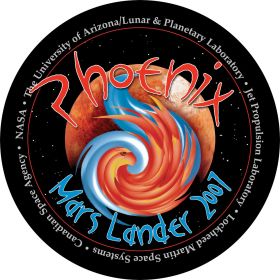 The Phoenix mission owes its name to the heritage from precursor missions that either failed (Mars Polar Lander, 1999) or were cancelled at a late stage (Mars Surveyor Lander 2001). The Phoenix spacecraft was successfully launched on Aug. 4, 2007 and shall land on May 25, 2008 in the Martian arctic region. It shall analyze near-surface water ice that is expected at the landing site. The Primary Mission lasts 90 sols and is followed by the Polar Climate Phase (60 sols). The mission will end late in 2008 due to lack of solar power.
The Phoenix mission owes its name to the heritage from precursor missions that either failed (Mars Polar Lander, 1999) or were cancelled at a late stage (Mars Surveyor Lander 2001). The Phoenix spacecraft was successfully launched on Aug. 4, 2007 and shall land on May 25, 2008 in the Martian arctic region. It shall analyze near-surface water ice that is expected at the landing site. The Primary Mission lasts 90 sols and is followed by the Polar Climate Phase (60 sols). The mission will end late in 2008 due to lack of solar power.
|
|
Science Objectives |
||||
|
|
The Launch |
||||
|
|
The Journey |
||||
|
|
The Landing |
||||
|
|
The Spacecraft |
||||
|
|
MPS contribution
|
||||
|
|
Timetable |
||||
|
|
Related links |
||||
|
Phoenix publications by MPS members |
The Phoenix spacecraft was successfully launched on Aug.4, 2007, aboard a Delta II rocket from Cape Canaveral, Florida.
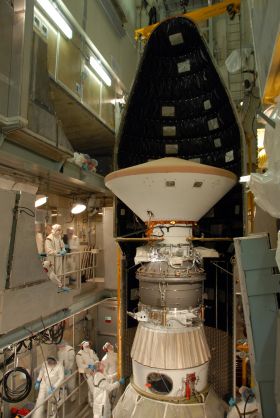 Integration of the Phoenix Spacecraft into the 3rd stage of a Delta II rocket. Credit: NASA.
Integration of the Phoenix Spacecraft into the 3rd stage of a Delta II rocket. Credit: NASA.
|
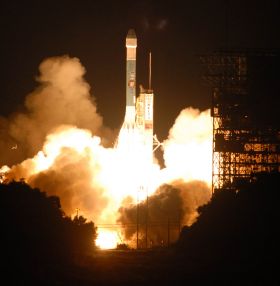 Launch on Aug. 4, 2007, 5:26:31 a.m. (EDT). Credit: NASA.
Launch on Aug. 4, 2007, 5:26:31 a.m. (EDT). Credit: NASA.
|
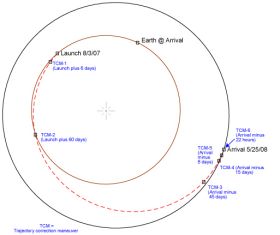 The trajectory from Earth to Mars includes six Trajectory Correction Maneuvers (TCM), cf. figure.
The trajectory from Earth to Mars includes six Trajectory Correction Maneuvers (TCM), cf. figure.
Trajectory of the Phoenix Spacecraft. Credit: JPL.
The current landing site is located at 127°W, 68.3°N (figure). Entry Descent Landing (EDL, cf. figure) lasts about 8 min. EDL key events include (altitude given in parentheses):
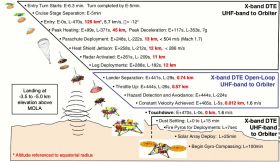
Entry Descent Landing (EDL). Credit: JPL.
The Phoenix science payload is composed of seven units (figures):
Besides development and integration of RAC und MECA-OM focal plane the MPS participates in the Phoenix project with following tasks:
| Event | Earth Time | Mars Time | Status |
|---|---|---|---|
| Launch | Aug. 4, 2007 | ||
| Landing, Start Primary Mission |
May 25, 2008, 68.3°N, 127°W on Mars |
sol 0, late NH spring (Ls=77°) | |
| End Primary Mission, Start Polar Climate Phase |
Aug. 26, 2008 | sol 90, early NH summer (Ls=118°) | |
| End Polar Climate Phase | Oct. 26, 2008 | sol 150, mid NH summer (Ls=148°) | |
| End of Mission? | Dec. 25, 2008 | sol 208 , end of NH summer (Ls=180°) |
Phoenix Mission Timetable: NH = Northern Hemisphere. The parameter Ls (Aerocentric Longitude of the Sun) specifies the position of Mars in its orbit around the sun. Ls = 0° and 90° are the beginning of NH spring and summer, respectively.
|
Phoenix @ JPL |
|
|
Phoenix @ Lockheed Martin Space Systems |
|
|
Phoenix @ University of Arizona (UA) |
|
|
Phoenix @ NASA |
| © 2009, Max Planck Institute for Solar System Research, Lindau |
Walter Goetz 07-10-2008 |